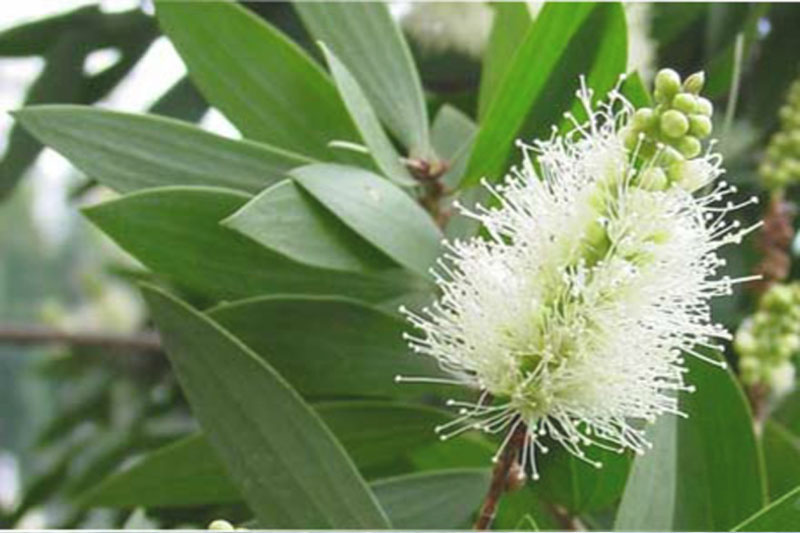Quick Facts
Botanical Name: Melaleuca leucadendron
Family Name: Myrtaceae
Common Name: Cajeput , Paper barks or punk trees
Part used: leaves and twigs
Specific Gravity: 0.912 -0.925
Optical Rotation: 5.0-7.5 at 25° C
Refractive Index: 1.4660-1.4710
Blends Well With: Angelica, Eucalyptus, Clove, Mint, Wintergreen
Uses: Nasal congestion relief, pain relief ointments, antifungal medication, Studies have proved that the oil combines well with convectional antibiotics. This oil helps to maintain a healthy digestive system.
Countries where it's found
The Cajeput tree is predominantly found in the Malay Archipelago, Spice Islands, South East Asia, Sulawesi, and hotter parts of the Australian continent.
Harvest Information
The leaves of the Cajeput tree are harvested under dry and hot weather conditions. This ensures maximum yield.
History of the Plant
The name Cajeput is derived from the Indonesian name, "kayu putih" meaning white wood. The tree is highly regarded through the East and has many therapeutic and herbal uses.

Extraction Process
The plant leaves are collected on a hot dry day and macerated in water. Later, the mixture is distilled after fermenting for a whole night. The extracted oil is colourless to pale yellow in colour with a pungent odour and bitter minty taste.
Commonly known Benefits
Medicinal Benefits
Cajeput oil is well known for its antibiotic and anti-fungal properties. It acts as a mild analgesic, diaphoretic, insecticide, and expectorant.
The essential oil of Cajeput kills or inhibits the growth of microorganism.
It is also used as a medicine to relieve aching joints and stiff bones.
The oil's anti-bacterial properties clear congestion, cold, and cough. It acts as a good inhalant for sinus infections.
The oil's anti-neuralgic property reduces muscle pain and rheumatism.
Cajeput oil is an excellent and a natural deterrent for fleas and head lice.
Its antimicrobial properties prevent septic infections and promote quick healing of cuts, bruises, and wounds.
The oil is often used in the form of ointments and also to treat toothaches and earaches.
Cajeput oil's anti-inflammatory properties aid in relieving burns, dyspepsia and influenza.
The essential oil of Cajeput aids in maintaining a healthy digestive system. It prevents constipation and digestive tract infections.
It also applied to treat indolent tumors.
Its anthelmintic properties eliminate intestinal worms while its carminative properties prevent flatulence.
Cajeput oil is an effective sedative. It relaxes irritable nerves thereby reducing the feelings of anger and depression. It also induces sound sleep.
This oil acts as an effective remedy when treating for diarrheas, nervous vomiting, and stomach cramps.
This oil is a good astringent.
The oil in diluted state is used in the treatment of eczema, scabies, and colic.
The Cajeput oil consists of a chemical called cineole that prevents yeast infections. This chemical relieves pain and skin irritation.
It is used to treat ringworm lesions and athlete's foot infestations.
The oil benefits the respiratory system, nervous system, relieves skeletal disorders, a diuretic, and a powerful stimulant.
Other Benefits
The oil is used a food flavoring agent in cooking and as a fragrance agent in soaps, perfumes, and cosmetics.
The Burmese mix Cajeput oil with camphor to treat bone problems.
Medical doctors in Vietnam have determined that the oil is effective for eternal applications.
Some interesting info
it is utilised mainly as a local application program in disease of the skin and as a arousing expectorator. Gently analgetic, disinfectant, antineuralgic, antispasmodic agent, sterilized (pneumonic, urinary, intestinal), healthful, diaphoretic, carminative, expectorator, antipyretic, insecticide, diaphoretic, tonic.
Cajeput (Melaleuca cajeputi) is in the family Myrtaceae. The oil is among the melaleuca trees that grow wild in Malaysia, Republic of Indonesia, the Philippine Islands, Socialist Republic of Vietnam, Java, Commonwealth of Australia and southeasterly Asia. The oil nowadays arrives from Commonwealth of Australia where steam clean distillment is utilized on the brisk leaves and branchlets. This is a big evergreen plant tree that matures up to ninety-eight fts in tallness.
It has heavy peaked leaves and white flowers. It uniquely has a flexible body with milklike, spongelike bark that chips away easily. Traditionally cajeput in the due east is utilised for common cold*, worries, septic sore throat*, toothache, sore and painful muscles, feverishness, atrophic arthritis and varied disease of the skin. It was utilised in the herbal tradition to develop a sense of warmness and speedup of the heart rate. Native peoples utilised it for prolonged laryngitis and bronchitis, cystitis, rheumatoid arthritis and to release ring worms.
Nowadays we note cajeput to have bactericide, antiparasitic, spasmolytic, anti-inflammatory drug and analgetic attributes. It is utilized as pharynx, lung, and venous sinus contagions, for urinary tract contagions, coughings, and intestinal troubles. Cajeput could be consumed internally along diluting it 50-50 with a vegetable oil, it could be diluted 50-50 and utilized on location, on the chakras/vita bend points, it could be in real time breathed in, or dispersed. Cajeput amalgamates intimately with wintergreen, eucalyptus tree radiata, juniper and peppermint. While for safety, cajeput is nonpoisonous, non-sensibilising but it could annoy the skin in high concentrations. Carefulness is advised to make a point you don't have celluloid cajeput since it could induce blistering and skin eructation.





